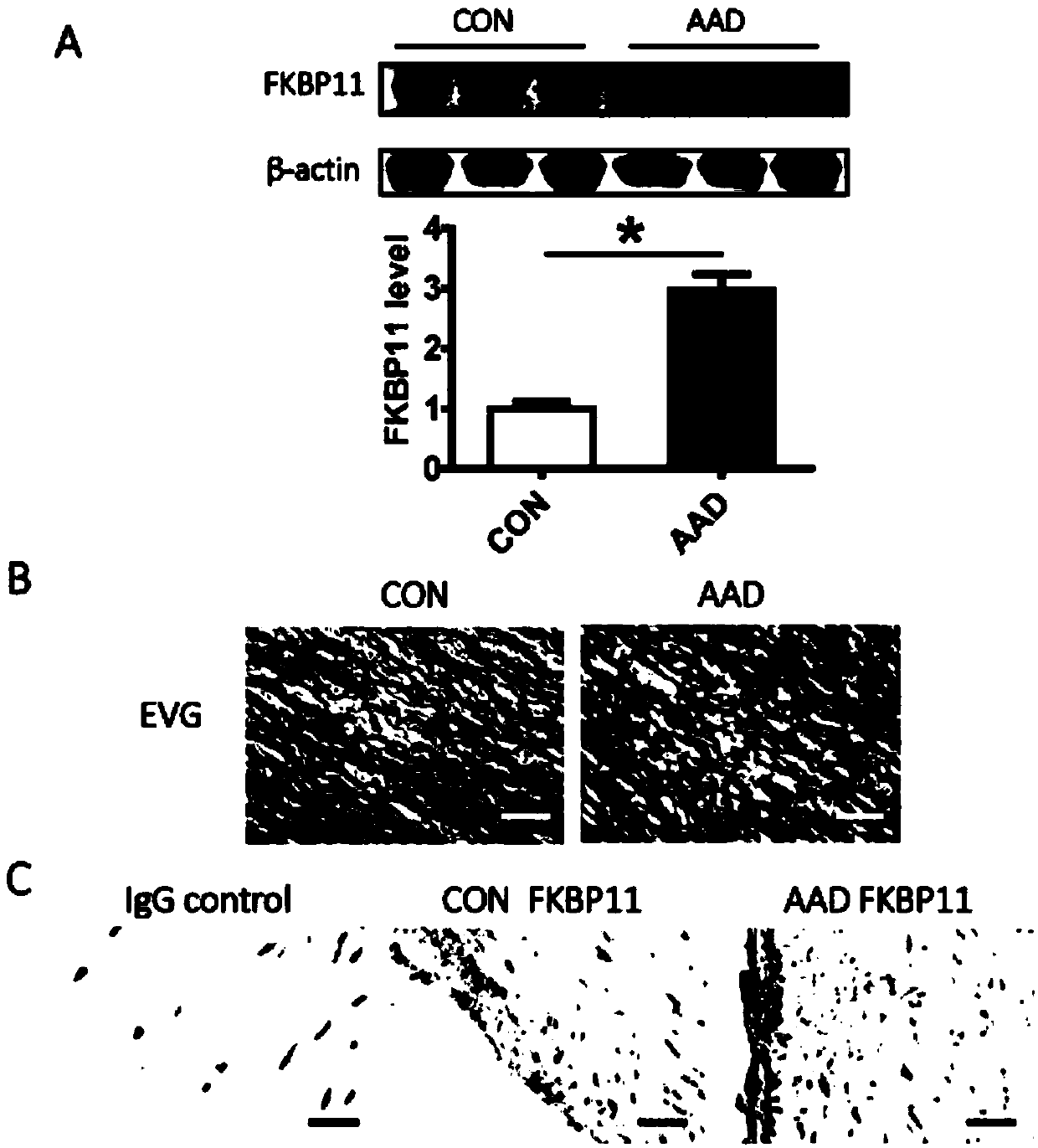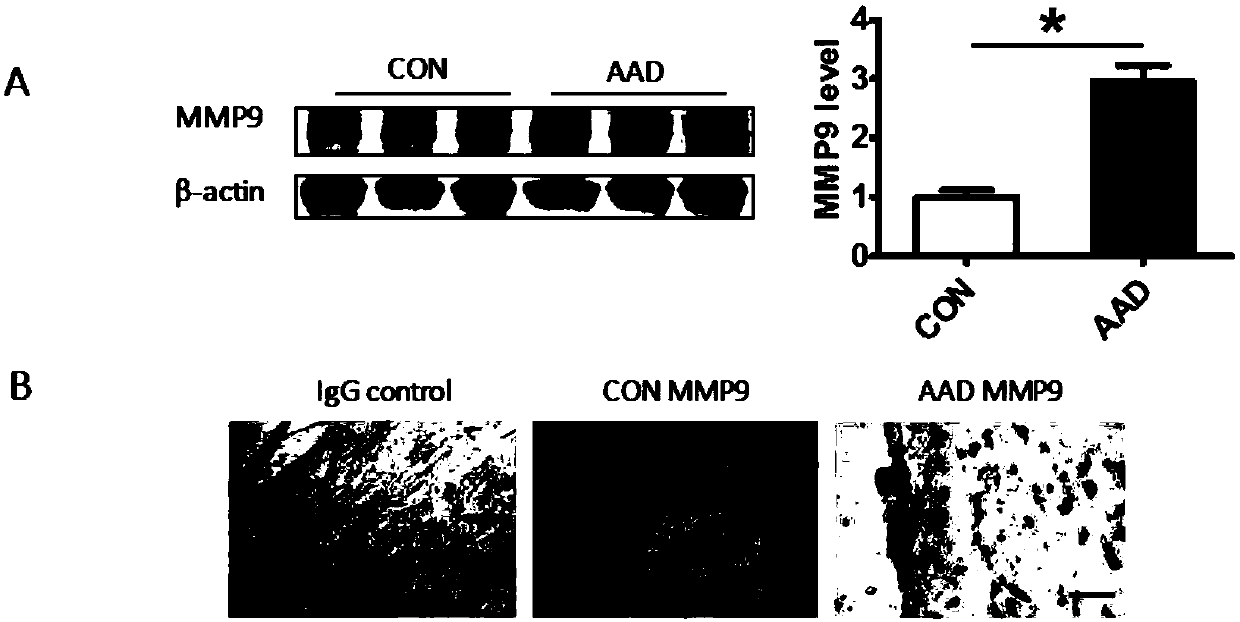Application of FKBP11 gene in prevention and treatment of aortic dissection
A technology of aortic dissection and gene, applied in gene therapy, medical preparations containing active ingredients, screening of compounds, etc., to achieve the effects of inhibiting migration, inhibiting degradation, and reducing expression
- Summary
- Abstract
- Description
- Claims
- Application Information
AI Technical Summary
Problems solved by technology
Method used
Image
Examples
Embodiment 1
[0058] Example 1: Discovery of the relationship between FKBP11 gene and acute aortic dissection:
[0059] The applicant used the whole aortic tissue RNA of patients with aortic dissection to obtain the transcriptome database by analyzing the Illumina HumanHT-12V4.0 gene chip (Illumina Inc., San Diego, CA, USA), and constructed a differential expression profile matrix using the WGCNA method Data, after removing outlier samples, carried out gene module analysis, gene enrichment analysis, hub gene screening, and the screened genes related to the occurrence and development of aortic dissection were verified by independent samples and isolated cell experiments, and FKBP11 was established as the target target gene.
[0060] The applicant used clinical samples of aortic tissue from patients with acute active dissection and normal aortic tissue samples as a control to study the relationship between FKBP11 gene and acute aortic dissection through Western Blot and immunohistochemical ex...
Embodiment 2
[0064] Example 2: FKBP11 gene causes the mechanism of action of aortic dissection disease
[0065] Endothelial cell damage is the initiating link of various cardiovascular diseases. When endothelial cells are stimulated by the outside world, the highly expressed FKBP11 of endothelial cells activates the NF-KB pathway by promoting p-P65 to enter the nucleus, increasing the expression of inflammatory factors in endothelial cells. Promoting the migration and differentiation of monocytes in the circulation causes macrophages to enter the aortic media through activated endothelial cells, and the aggregated macrophages will recruit more by secreting inflammatory factors (such as IL-6, MCP-1, etc.) Adhesion of inflammatory cells to endothelial cells and migration of tunica media aggravate the local infiltration of inflammatory cells. At the same time, macrophages will secrete a large amount of matrix metalloproteinases (MMPs) and proteases that can degrade structural proteins such as...
Embodiment 3
[0066] Example 3: FKBP11 gene knockdown significantly reduces the expression of pro-inflammatory factors and the migration of monocyte-macrophages
[0067] The applicant induced EA.hy926 endothelial cells with angiotensin-converting enzyme II (Ang II) to simulate the occurrence of aortic dissection in vitro.
[0068] 1. Screening and verification of effective FKBP11SiRNA:
[0069] (1) Cell culture: THP-1 cells ( tib-202 TM ) and EA.hy926 cells (Manassas, VA), cultured in RPMI 1640 (Gibco, CA, USA) containing 10% fetal bovine serum (Sigma-Aldrich, St.Louis, MO), containing 10mM HEPEs, 0.1mM MEM non Essential amino acids, 1 mM sodium pyruvate, and 100 nM penicillin / streptomycin (Life Technologies), maintained at 5% CO 2 , in a 37 °C cell culture incubator. Synthetic FKBP11-siRNA was purchased from Ruibo (Guangzhou, China), and the specific operation of transfecting cells was according to the manufacturer's protocol. Three artificially synthesized FKBP11-siRNAs, as follows...
PUM
 Login to View More
Login to View More Abstract
Description
Claims
Application Information
 Login to View More
Login to View More - R&D
- Intellectual Property
- Life Sciences
- Materials
- Tech Scout
- Unparalleled Data Quality
- Higher Quality Content
- 60% Fewer Hallucinations
Browse by: Latest US Patents, China's latest patents, Technical Efficacy Thesaurus, Application Domain, Technology Topic, Popular Technical Reports.
© 2025 PatSnap. All rights reserved.Legal|Privacy policy|Modern Slavery Act Transparency Statement|Sitemap|About US| Contact US: help@patsnap.com



